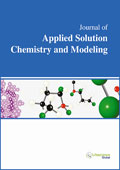jascm
|
|
Abstract: Acrylic, methacrylic and itaconic acids have Brønsted acidity given by carboxylic groups, and they are extensively used in polymerization for modification of several soft-mater materials. By this reason it is important to propose better characterization studies and alternatives to obtain more of their physicochemical properties. In this work the pKa values of these acids are obtained by adjusting NMR chemical shifts for hydrogen and carbon nuclei as a function of pH with program HYPNMR, and compared with those obtained by potentiometric and conductometric titrations. Keywords: pKa values, acrylic acid derivatives, HYPNMR, 1H NMR, 13C NMR.Download Full Article |
|
|
Abstract: The interrelationship between the conventional thermodynamics and energetics has been discussed in detail. A number of flavors has been considered in the field of energetics, with the conclusion that the actual difference among all of them is rather superficial. A need to reconsider the foundations of thermodynamics and statistical physics has been pointed out. Such a re-consideration ought to facilitate formulating thermodynamics at any level of matter organization: from the microscopic through nano- and mesoscopic to the macroscopic one. Keywords: Thermodynamics, Energetics, Enthalpy, Entropy, Statistical Mechanics.Download Full Article |
|
|
Abstract: Nowadays, photocatalysis is being applied as a promising technique for decontamination, purification, deodorization, etc. of polluted air and wastewaters. This technique attempts also to generate renewable and non-polluting fuels utilizing various carbon and hydrogen sources. In this context, studies on photo-catalytic generation of H2 using 0.1% w/v TiO2 photo catalyst as a suspension in water was carried out using 350 nm light. This was explored further in presence of various metal ions such as Ag+, Cu2+, Fe2+, Au3+ and V5+ at different ambient such as air and CO2, in presence of a hole scavenger (2-propanol and formic acid). H2 yields in CO2-purged systems as analyzed in GC-TCD were reasonably higher, and increased further when metal ions were added into the systems. Based on H2 yields, HCOOH was found to be a more supportive hole scavenger as compared to 2-propanol in metal ions containing systems. Besides the formation of low to high concentrations of various gaseous products, nanoparticles of gold, silver and copper were also observed as photolysis products. This indicated that the presence of both reduced metal ions and their in-situ generated nanoparticles at various stages either in the free/unbound and/or associated with TiO2 photocatalyst in aqueous systems, together play a significant role in enhancing the H2 yields. Keywords: H2, TiO2, hole scavenger, photolysis, metal ions, nanoparticles.Download Full Article |
|
|
Abstract: The partial molar volumes, isentropic compressibilities, partial molar isentropic compressions and transfer molar quantities of cyclic alanylalanine in water and in aqueous solutions of MnCl2, NiCl2 and ZnCl2 were determined using the experimental density and speed of sound values. Refractive indices of all the solutions were recorded to calculate the molar refractions. The molecular interactions existing in the systems have been discussed based on the derived parameters. It has been found that M2+-O2H bond distances of hydrated cations influence on the volumetric properties of cyclic alanylalanine. Further, the greater effect of hydrophobic hydration has been substantiated by the Sv values of least square fits of apparent molar volume against solute molality. Keywords: Partial molar volume, Partial molar isentropic compression, cyclic alanylalanine, hydrophobic hydration.Download Full Article |
|
|
Abstract: The absorption and steady state emission properties of a chemically synthesizedchalcone, 3-(4-methoxyphenyl)-1-(4-(pyrrolidin-1-yl) phenyl) prop-2-en-1-one (MPPP) containingasymmetrical donor and acceptor groups has been investigated both experimentally andtheoretically. The ground state, MPPP has a significant intramolecular charge transfer (ICT) character and a great sensitivity to the hydrogen bond donating ability of the medium as reflected from the absorption spectra in pure non polar, polar and neutral solvents. On the other hand, its excited singlet state exhibits high ICT characters as manifested by the drastic solvatochromic effects. These results are consistent with the data. The absorption spectra of the compound MPPP undergoes minor changes with increasing polarity of the solvents and the fluorescence spectra experiences a distinct bathochromic shifts in the both position and fluorescence quantum yields, increases reaching a maximum before decrease with increasing the solvent effects. The quantum yields decrease with increase in the solvent polarity. The magnitude of change in the dipole moment was also calculated using Austin Model 1 (AM1). These results suggest that the evidence about the intramolecular charge transfer in the emitting singlet state of this compound. The solvent dependence of quantum yields of MPPP was interpreted on the basis of positive and negative solvatokinetic as well as hydrogen bonding effects. Intramolecular charge (ICT) transfer took place from pyrrolidine nitrogen to α, β unsaturated carbonyl in the ground state.. Keywords: Chalcone, Solvatokinetic, Intramolecular charge transfer, Dipole moment, AM1 method.Download Full Article |


